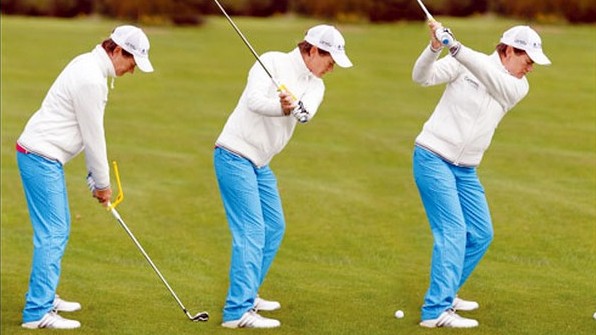Catriona Matthew has been working with SGU National coach Kevin Craggs for the past two and a half years. Kevin highlights the key moves they work on – and the drills that can similarly help you improve your swing
One of the keys to Catriona’s consistency is that she works on the foundation of her swing and the fundamentals that shape it. The little things like having a good solid base should never be neglected. I always talk about stability in the swing – a vital element for all golfers. Catriona controls this by having great posture at address and a consistent width of stance. Her weight distribution is also constant so that she is able to swing with great balance and poise. The resistance band exercise you see here is one of our favourites in what I like to call ‘supervised practice’, so that even when I’m not travelling with her to a tournament, Catriona can rely on this drill to ensure she is practising the right moves in the correct manner. These training aids are a useful addition to every golfers bag. They give you a focus and plan to your practice.
Band aid! A simple drill for better stability
Inconsistencies in the swing can often be traced to poor balance and stability in the lower body – and this drill is designed to help you avoid those problems. Kevin suggested using a resistance band as part of my warm up routine and it has definitely helped me to take care of the very fundamentals we work on together. With the band looped around my legs, as you see here, I am immediately aware of the strength in my legs and the role they play in stabilising the swing.
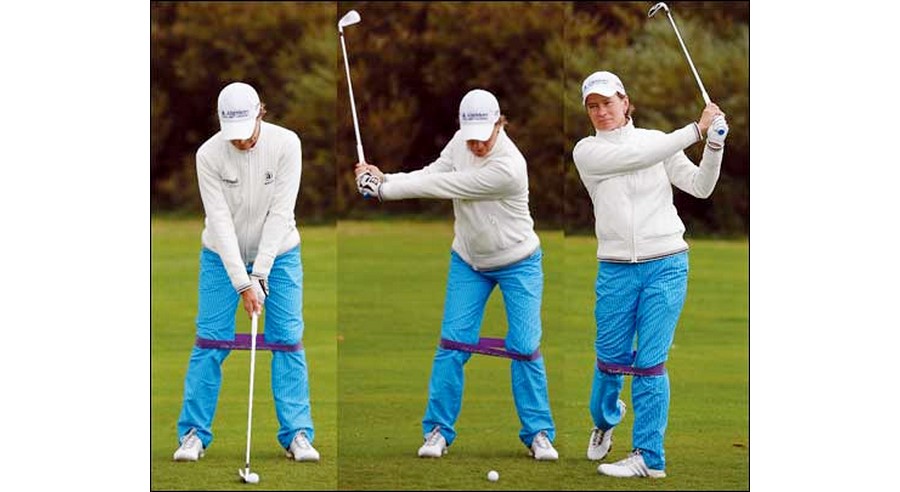
Key is then to keep that tension in the band as I load up the swing
I start by getting into a good posture at the set up, gently flexing my knees and creating tension in my quads so that the band is stretched. In the backswing, I focus on maintaining the tension in the band – achieved via a strong but relatively passive leg action. This stabilises my swing and also acts as an exercise to strengthen my glutes, giving me a strong lower body, which helps me strike the ball consistently. It’s an exercise I recommend.
Kevin Craggs says…
“One of the keys to a solid swing lies in establishing a good spine angle at address – and keeping this constant throughout the swing. This is certainly a key element for Catriona. Better angles = better balance, which simplifies the idea of swinging the club around your body.
Historically Catriona used to struggle with her takeaway, setting her wrists poorly in the backswing, which meant she had to manipulate the club up onto plane. To resolve this, we work regularly on this first move, often with the help of the Swingyde you see Catriona using here. This ingenious little device clips onto the grip and provides immediate feedback on the quality of the wrist action and forearm rotation in the early stages of the swing. It’s one of the few training devices I would urge amateurs to try.
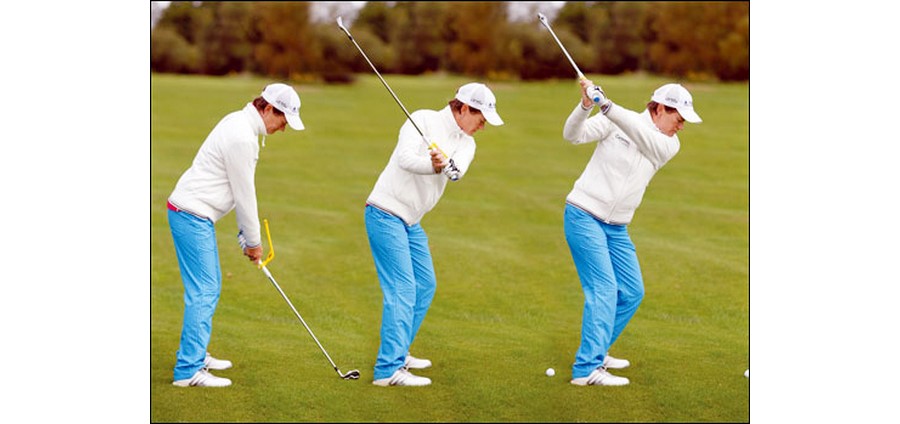
As my left arm rotates across the chest and the wrists hinge up, I’m looking for the arms of the Swingyde to fit neatly onto my left wrist
Once I’m in that slot at halfway back, all I have to think about is completing my shoulder turn – and maintaining good posture angles – to achieve a solid position at the top
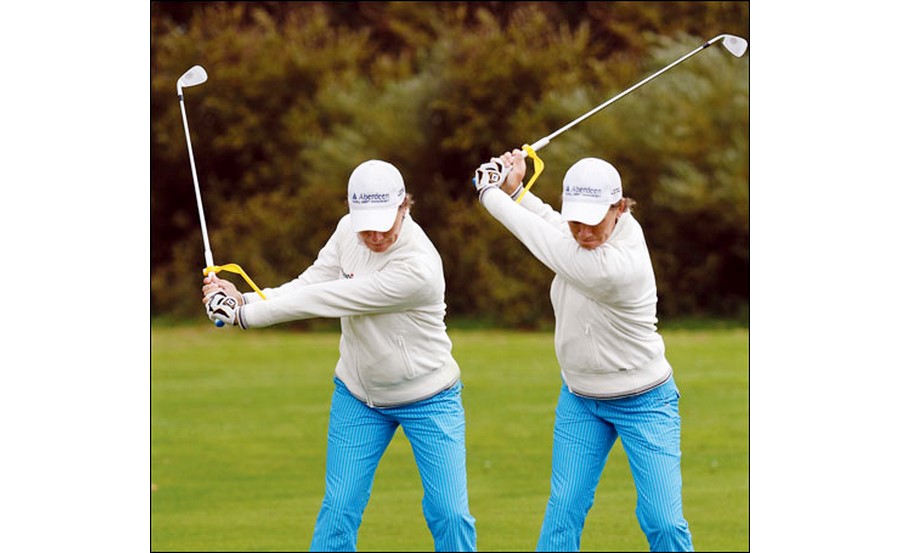
“I’ll hit 10 shots using the Swingyde with an 8-iron and then 10 shots without. Whilst I’m doing that I’ll get my caddy and husband Graham to switch the Swingyde onto a harder club like a 5-iron and do the same drill.
I’ll use the Swingyde with every club from my wedge through to my driver to help supervise my practice. I used to find I was a bit aimless with my practice but with this simple training aid I now have total focus.”
Catriona says…
“The Swingyde is easy to use and helps you to develop better wrist ‘set’ and arm/body movement in the critical first moves of the backswing. With the device fitted to a mid iron, I focus on swinging the club to the halfway point, emphasising the ‘set’ in my wrists to feel the correct position. Out of the corner of my eye I can instantly see that my set position is correct from the Swingyde pointer.
Once I have the feel for the first move, all I have to do is carry on turning my shoulders to complete the backswing – and I continue on to strike the shot with confidence in the knowledge that my swing is on plane. Try it.
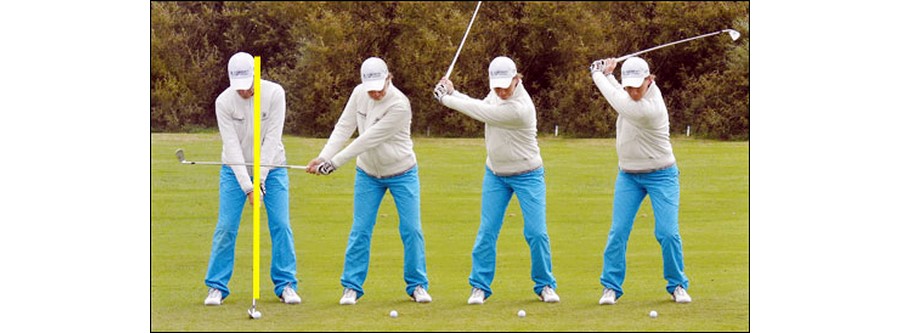
Wrists and forerams work nicely to get the club swinging away in harmony with my body.
The wrists fully ‘set’ by the time I pass the halfway point.
Full shoulder turn rewards me with a solid position at the top – fully coiled

Excellent forearm rotation away from the ball, the wrists in the process of‘setting’ the club.
Wrists now fully hinged, the club on a good plane as it swings up
Find the rhythm that helps you blend a fluent swing
As Kevin has mentioned earlier, it is the simplicity of the ideas we work on that enable me to maintain my consistency – no point over-complicating things! And the basic checkpoints I look for at the set-up help me to maintain a posture that promotes good coordinated movement. There are three checks I constantly make when I set up to the ball:
(1) Looking down the line, I want to see the centre of my knees directly above the lace line (I don’t ever want to see the knees forward of the lace line of my golf shoes)
(2) The centre of my shoulders should be just in front of my toes (as per the annotation in the photo above)
(3) Looking face on, my left ear should be in line with the ball So, when it comes to taking care of the fundamentals at the set up, it’s basically the feet, the knees, the shoulder line and the head line that I make sure are correct – the constant points that give me swing (and yours!) consistency. There is no substitute for working on and checking these key details.
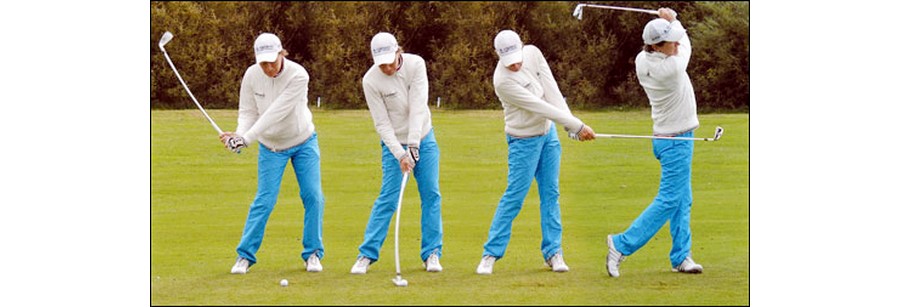
The hips and shoulders nicely‘in sync’ through impact – neither is out-racing the other.
Right forearm rotates over the left in process of releasing the club to a full finish.

Head beautifully still as the club is delivered – a crisp ball-then turf contact.
Balance and rhythm maintained all the way to the finish – a must for control.
Keving Craggs says…
“The inner swings the outer” I see far too many amateur golfers who are guilty of being too ‘armswing’ dominant. What I mean by this is that they tend to let their arm-swing overtake their body action. It’s one of the swing faults that we’ve worked on preventing in Catriona’s move; by focusing on the rotation of the bigger muscles in her body – the ‘core’ muscles – she has developed a very reliable body action. I refer to this as ‘the inner swinging the outer’, which basically means the core (centre of my body) controls the swing, not the hands and arms.
Catriona says… “Intelligent practice”
Many ladies on Tour spend hours beating balls on the range but experience has taught me the importance of practising intelligently, which means working harder for less time but on the right things for the tournament week. Here in Europe play so many different types of courses that different shots are required every week. Which means I might have to work on high lobs around the greens one week or bump and runs the next. The important thing is to practice intelligently and productively for that event.
Originally published in 2014
